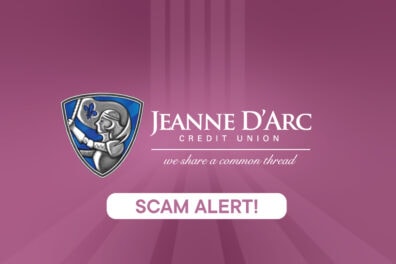Everything you need to know about fake fraud alerts

One of the most prevalent scams out there today is phishing. This is when a fraudster sends an email or other communication pretending to be from a legitimate company and tricks the recipient into divulging important information, such as a credit card number, social security number or login credentials.
One type of phishing scam is a phony fraud alert.
Many financial institutions are dedicated to making sure their members/customers are always notified when there is potential fraud on their accounts. Scammers know this, and view this as yet another way they can fake their way into people’s inboxes, text messages, and ultimately, bank accounts.
By sending phony fraud alerts via email or text, scammers trick you into giving up your credit/debit card or bank account information.
You may receive an email or text message that seems completely real and informs you that:
- Your card has been cancelled because it was used fraudulently or the information may have been stolen, or
- There was a suspicious transaction made on your account
Of course, at this point, you might panic and feel the need to take immediate action. In fact, the scammer relies on your desperation to resolve the issue as soon as possible. That’s why the message will provide instructions on how to set things straight. This may include:
- A link that you can click to “validate” your card or account information.
- A phone number you can call, which if dialed, will connect you right to the scammer.
- The question, “Did you shop at XYZ?” and two buttons, “Yes” or “No”. If you click “No”, you will be directed to a page where you enter and submit your information.
If you do click the link or make the call and fall for the trap, you provide the fraudster with access to your money and other personal details.
In some cases, the fraudster may have already stolen your credit card number and expiration date. They may ask you to provide the 3 or 4 digit security code, which will complete the details they need to make purchases online or over the phone.
What to do if you receive a phony fraud alert
If you receive an email or text that fits the above description, it is crucial that you question its legitimacy.
First off, DO NOT click on anything provided in the message, including links, buttons, attachments or phone numbers. DO NOT call any phone number included in the email.
The first action you should take is to contact the financial institution directly, but use the phone number on the back of your credit/debit card or on the financial institution’s website. This way you know that the other person on the phone will definitely be a representative from the financial institution and not a scammer.
When you do this, you accomplish multiple things at the same time:
- You confirm whether or not the message is real
- You can remediate the situation right then and there
- If the message was fraud, you inform the institution that there are spoof messages circulating to its customers, and potentially to non-customers.
What not to do if you receive a phony fraud alert (or any suspicious email, text or phone call)
- Again, never click any link or open any kind of attachment
- Never provide your personal information, credit/debit card details or online login credentials
- Never reply
REMEMBER – Your bank, credit union or credit card company will NEVER contact you in any way and ask you to provide your information.
If you do receive an email, text or phone call, and aren’t sure if it’s legitimate, call the company directly using the phone number on the website, the back of your card, your statement or other communication.
If the person is adamant that you provide your details, you can be sure it’s fraud.
Staying vigilant against any kind of scam is so important these days. If you think you may have fallen victim, contact your financial institution immediately and report your case to ic3.gov.
Subscribe to The Money Mill to get a link to our free online financial wellness program that’s designed to help you successfully manage your financial life. Plus, you’ll receive emails whenever we publish a new article so you’ll never miss a beat! We promise, no junk mail.



